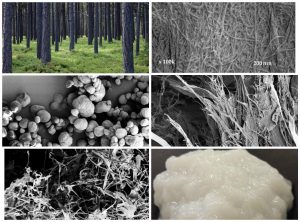Nanocellulose Research and Development
 Nanocellulose-based materials have much potential for the manufacture of high-performance products. This is due to the unique properties of cellulose nanocrystals (CNC) and cellulose nanofibrils (CNF), whose physical and chemical properties are very different from properties of cellulose at the macro scale. Nanocellulose-based materials have high strength and low weight. The highest grades have attributes that offer great reinforcing strength and/or optical clarity, while lower grades can offer increased strength and improved properties at lower costs.
Nanocellulose-based materials have much potential for the manufacture of high-performance products. This is due to the unique properties of cellulose nanocrystals (CNC) and cellulose nanofibrils (CNF), whose physical and chemical properties are very different from properties of cellulose at the macro scale. Nanocellulose-based materials have high strength and low weight. The highest grades have attributes that offer great reinforcing strength and/or optical clarity, while lower grades can offer increased strength and improved properties at lower costs.
Up to now, CNF and CNC commercialization efforts have been hampered by the lack of material in sufficient quantities to conduct meaningful technology demonstrations. To address this shortage, the USDA Forest Service, Forest Products Laboratory (FPL) and the UMaine Process Development Center are working together to produce and distribute CNC and CNF in various forms for academic and industrial research. The FPL and UMaine have been research partners since April 2011 when they began converting wood components into nanomaterials and developing new generations of high-performance wood-based materials.
Cellulose Nanotechnology Research Consortium
The Nanocellulose Research Program at UMaine is part of a research consortium led by the Forest Products Laboratory. The consortium includes six other universities — Georgia Institute of Technology, North Carolina State University, Oregon State University, Pennsylvania State University, Purdue University and University of Tennessee. Consortium members are working together to develop scalable methods to convert wood components into novel, high-performance nanomaterials. Their work is also being directed at improving methods to isolate, characterize, and develop standards for the various forms of nanocellulose.
